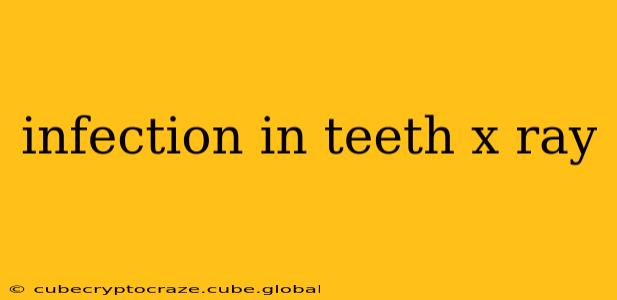Dental x-rays are indispensable tools for dentists to diagnose a wide range of oral health issues, including tooth infections. While a visual examination can often reveal signs of infection, x-rays provide crucial insights into the underlying structures of the teeth and surrounding bone, allowing for a more accurate diagnosis and effective treatment plan. This guide will delve into how dental x-rays reveal tooth infections, what to expect during the process, and answer frequently asked questions.
What do x-rays show regarding tooth infections?
Dental x-rays can reveal several key indicators of a tooth infection, often referred to as apical periodontitis or periapical abscess. These include:
-
Periapical Lesions: These are areas of bone loss or destruction around the root tip of the tooth. Infections cause the body's immune system to fight back, leading to bone resorption visible as a radiolucent (darker) area on the x-ray. The size and shape of the lesion indicate the severity and extent of the infection. A small, localized lesion might signify an early stage infection, while a large, diffuse lesion points to a more advanced and potentially serious infection.
-
Widening of the Periodontal Ligament Space (PDL): The PDL is a thin space between the tooth root and the surrounding bone. Infection can cause inflammation and widening of this space, appearing as a dark line around the root on the x-ray.
-
Root Fractures: While not always directly related to infection, root fractures can create an entry point for bacteria, leading to infection. X-rays are essential to detect these fractures, which may not be visible during a visual examination.
-
Changes in Tooth Structure: Severe infections can sometimes cause noticeable changes in the tooth structure itself, such as internal resorption (the loss of tooth structure from the inside out), which might be visible on the x-ray.
How are x-rays used to diagnose a tooth infection?
The dentist will typically take several types of x-rays to assess the situation thoroughly:
-
Periapical X-rays: These show a single tooth and the surrounding bone in detail, making them ideal for detecting periapical lesions.
-
Bitewing X-rays: These capture images of the crowns and interproximal spaces (between teeth) of the upper and lower teeth, useful in identifying cavities or bone loss that could contribute to or indicate infection.
-
Panoramic X-rays: These provide a wider view of the entire mouth, showing all teeth and supporting structures. While less detailed than periapical x-rays, they can be helpful in identifying more widespread infections or problems.
The dentist will carefully interpret these images, considering the clinical symptoms, such as pain, swelling, and sensitivity to determine the extent and nature of the infection.
What are the different types of tooth infections shown on x-rays?
While x-rays primarily reveal the effects of an infection (bone loss, etc.), they help diagnose different types of infections indirectly:
-
Acute Apical Abscess: This is a severe infection characterized by rapid onset, intense pain, and swelling. On x-rays, this might show a significant periapical lesion and widening of the PDL.
-
Chronic Apical Abscess: This is a slower-developing infection with less intense symptoms. X-rays might reveal a smaller periapical lesion or a more diffuse area of bone loss.
-
Apical Periodontitis: This refers to inflammation of the tissues at the root tip of the tooth, often preceding the formation of an abscess. X-rays show varying degrees of bone loss depending on the stage.
What if the x-ray doesn't show an infection, but I still have symptoms?
Sometimes, early-stage infections or infections in hard-to-reach areas might not be clearly visible on x-rays. If you're experiencing symptoms such as pain, swelling, or sensitivity, despite a seemingly normal x-ray, your dentist may conduct further investigations, such as taking additional x-rays, performing a clinical examination, or taking samples for laboratory testing.
Can x-rays be used to monitor the healing process of a tooth infection?
Yes, follow-up x-rays are often used to monitor the effectiveness of treatment and observe the healing process. Improvements will typically show as a reduction in the size of the periapical lesion and narrowing of the PDL space. Regular monitoring ensures that the infection is resolving as expected and that the treatment plan is successful.
How often are x-rays needed to monitor a tooth infection?
The frequency of follow-up x-rays depends on the severity of the infection and the treatment plan. Your dentist will determine the appropriate schedule based on your individual case, which might range from a few weeks to several months.
This information is for general knowledge and doesn't replace professional dental advice. Always consult a dentist for diagnosis and treatment of any oral health concerns.
